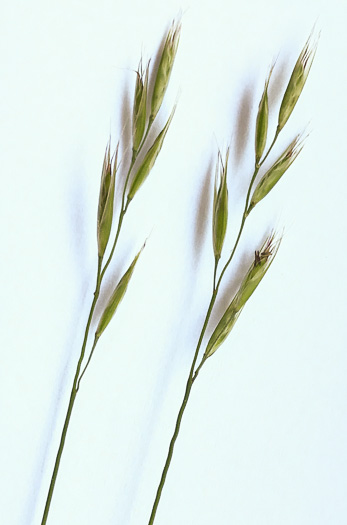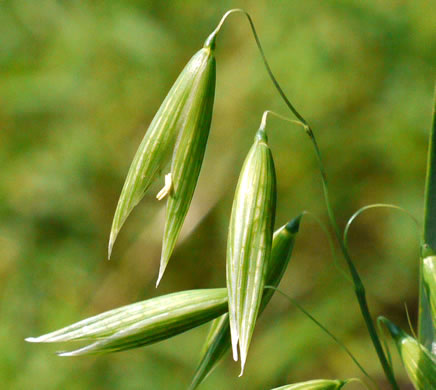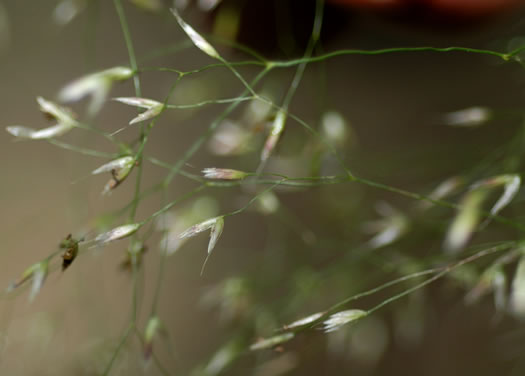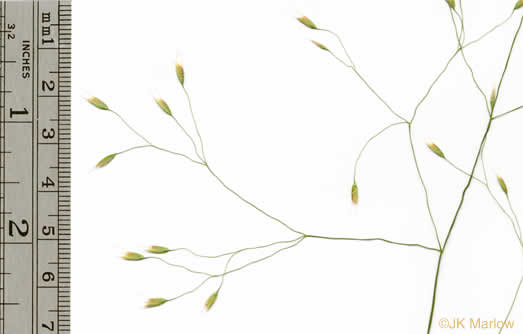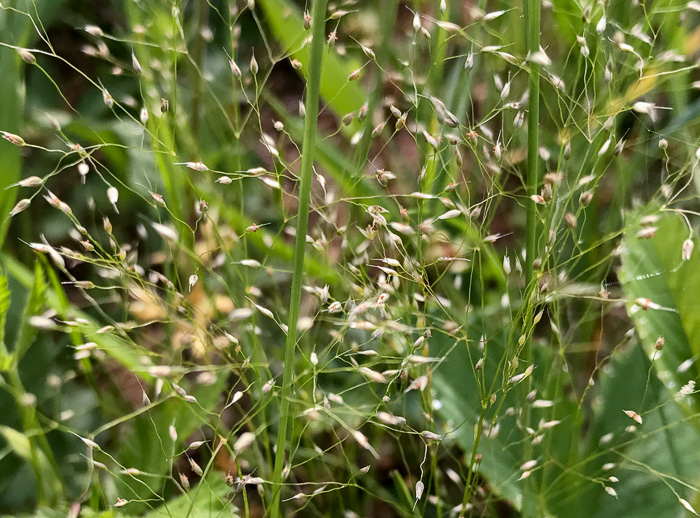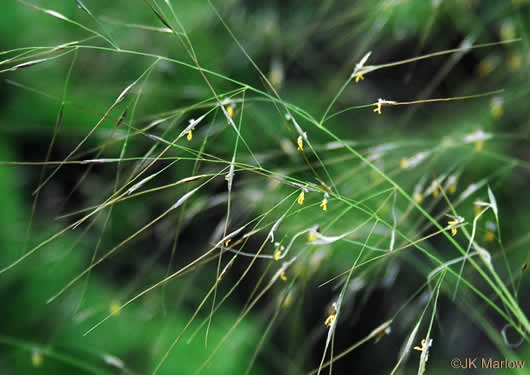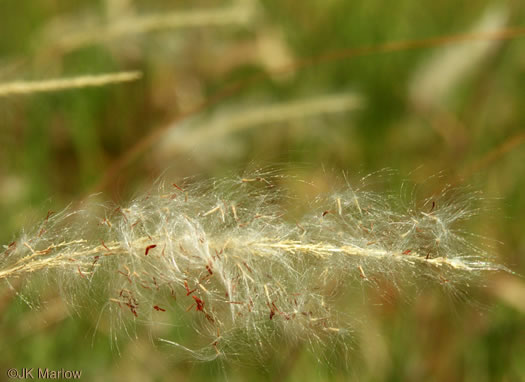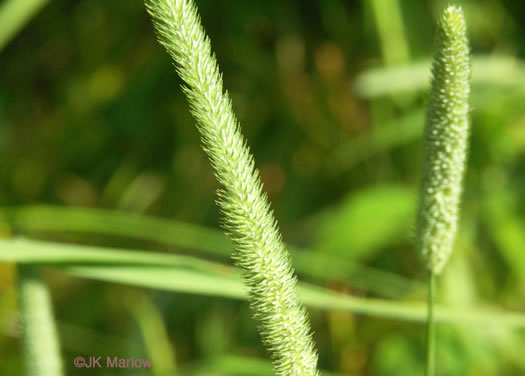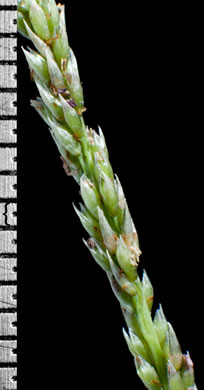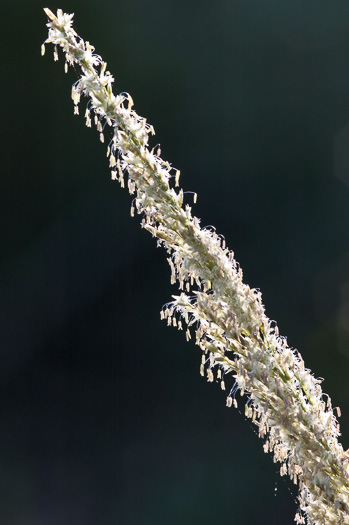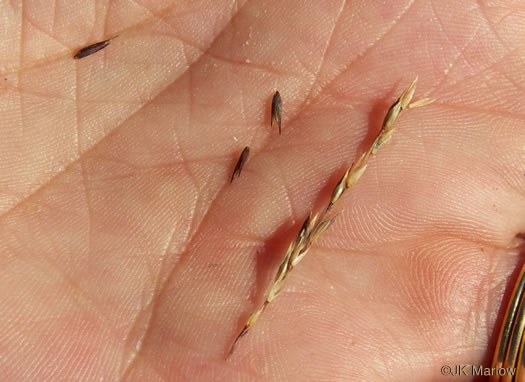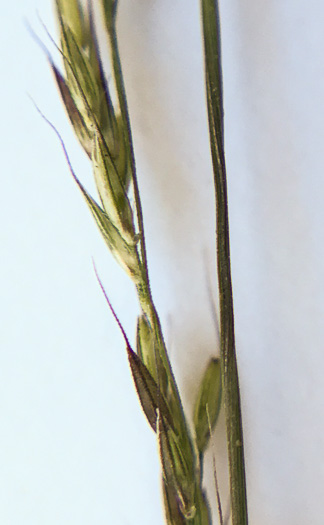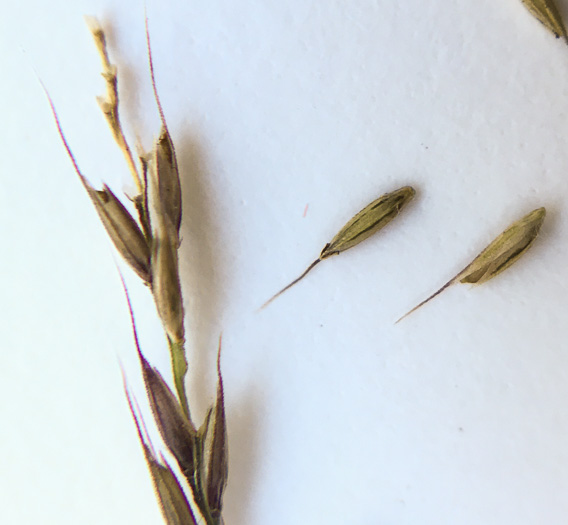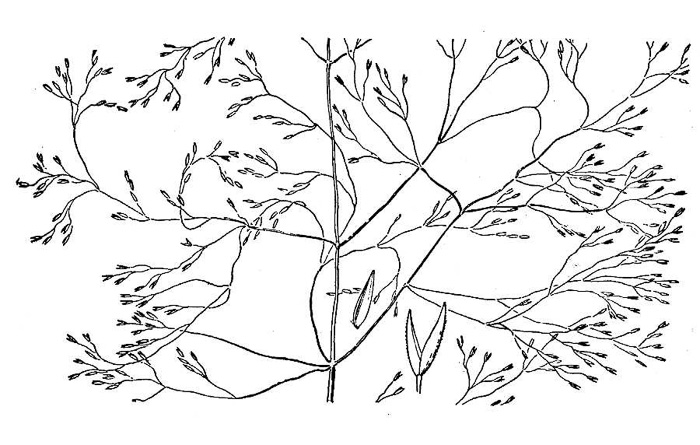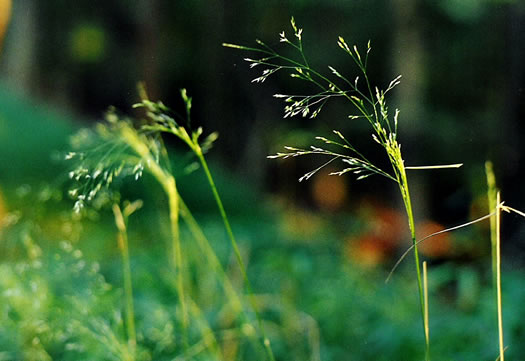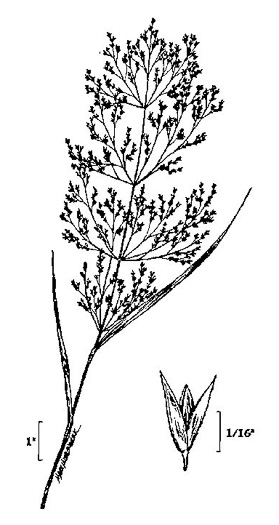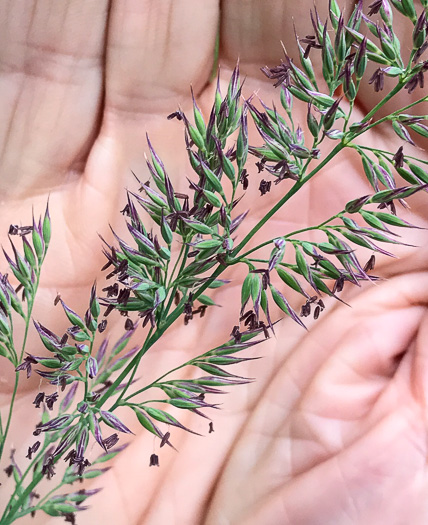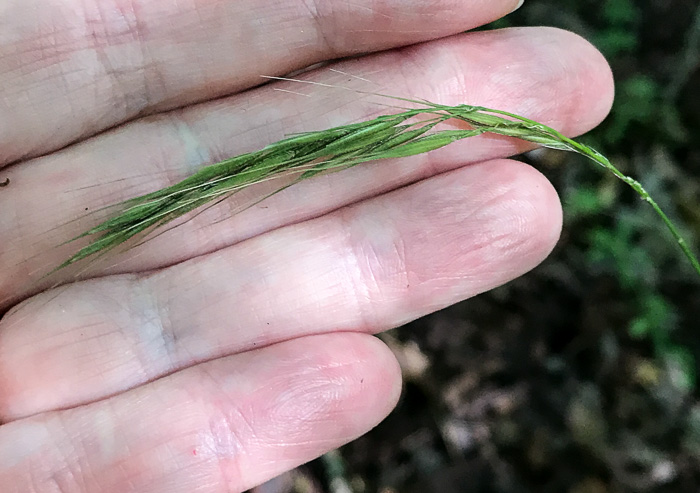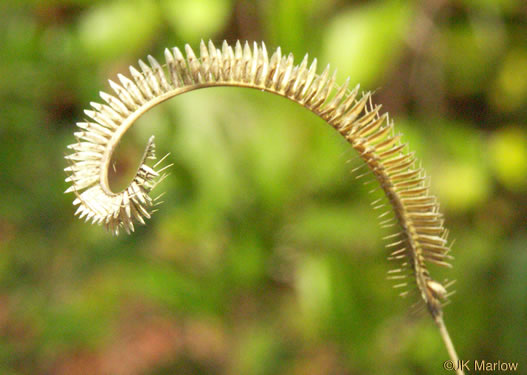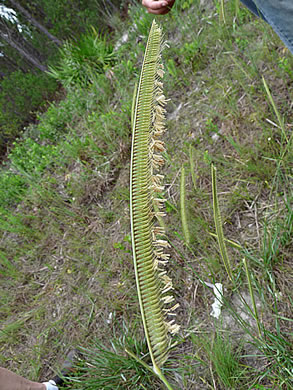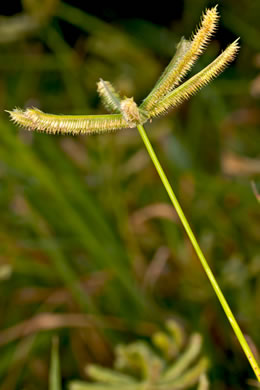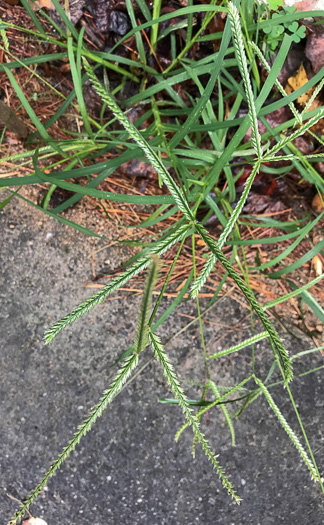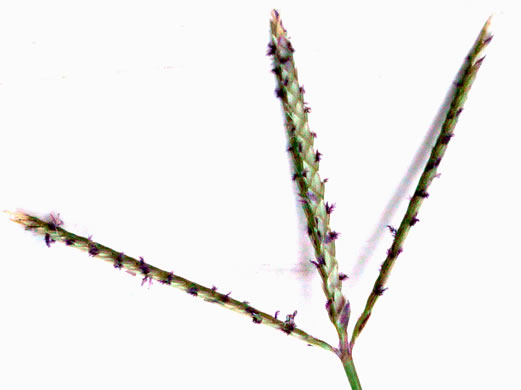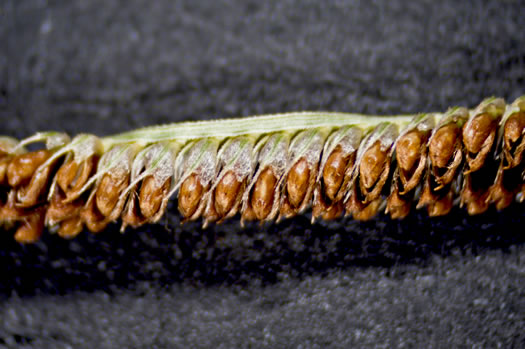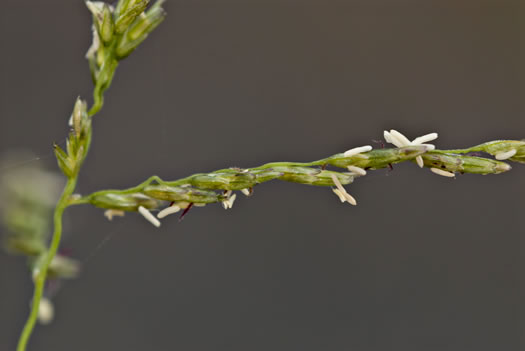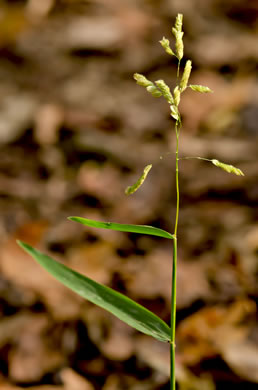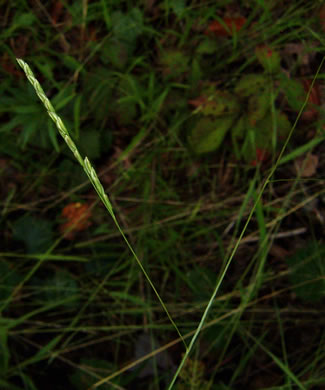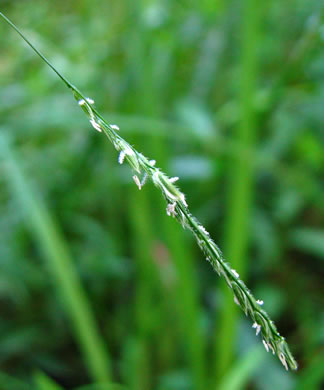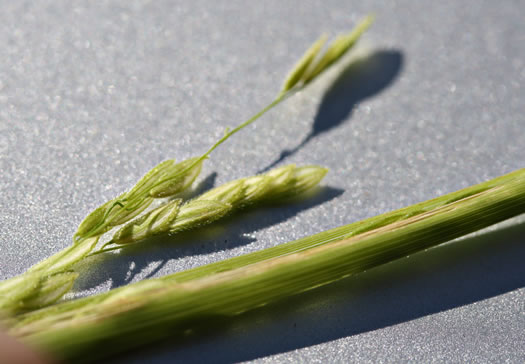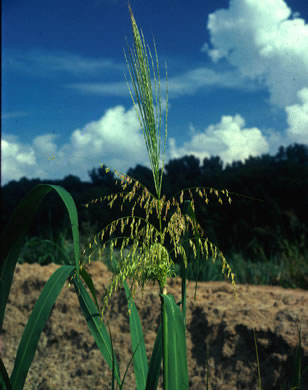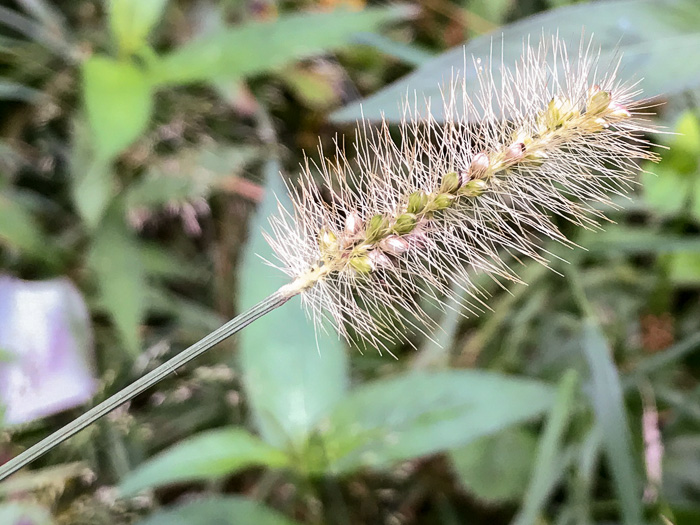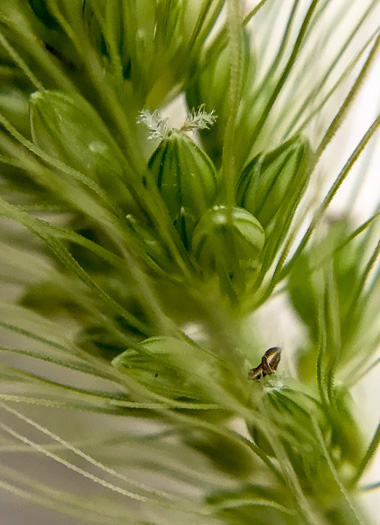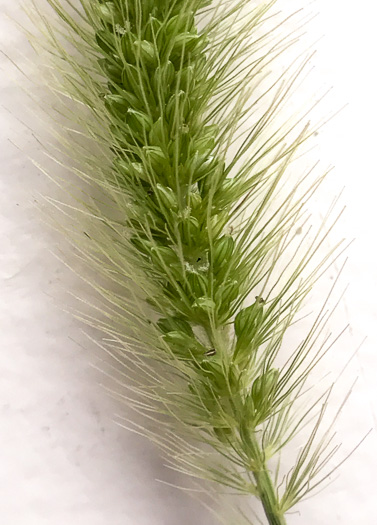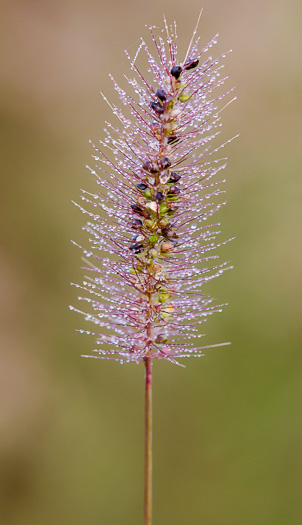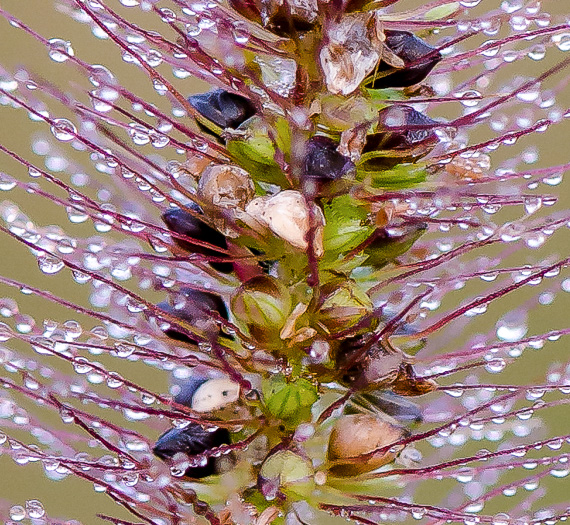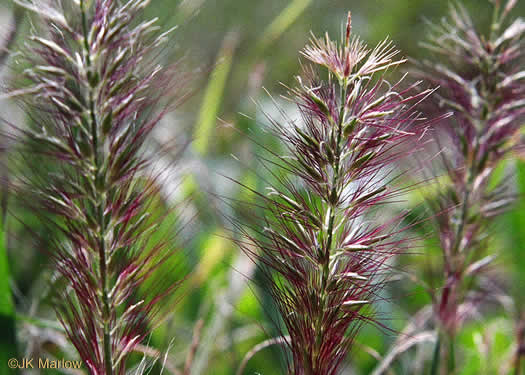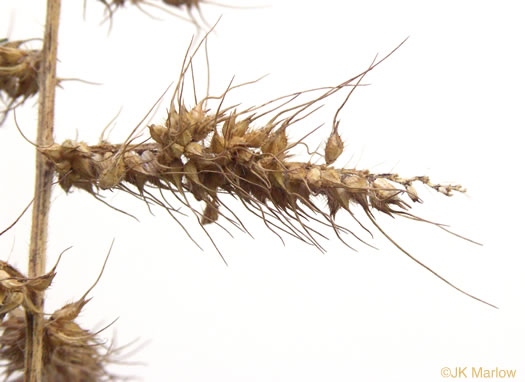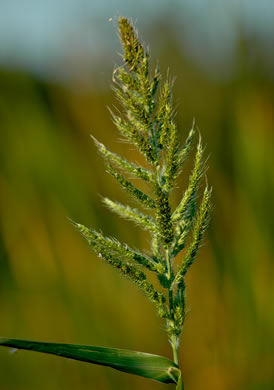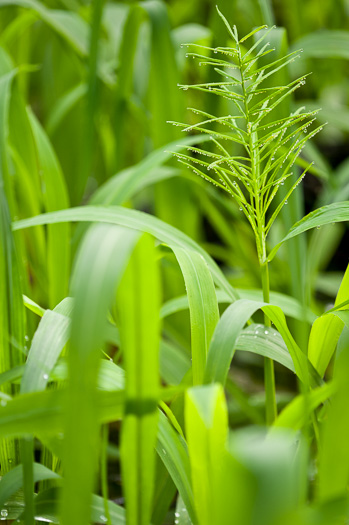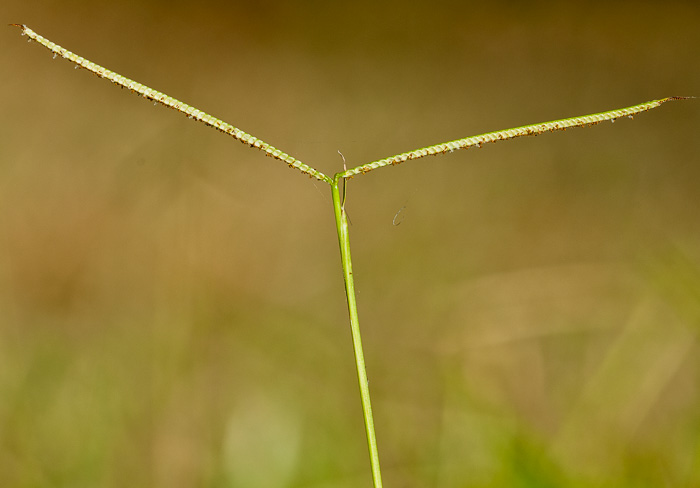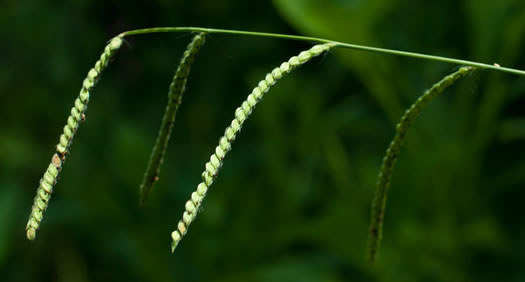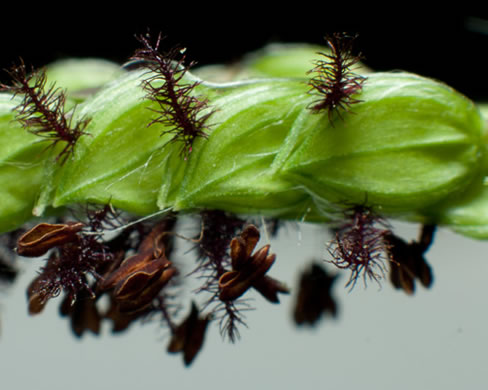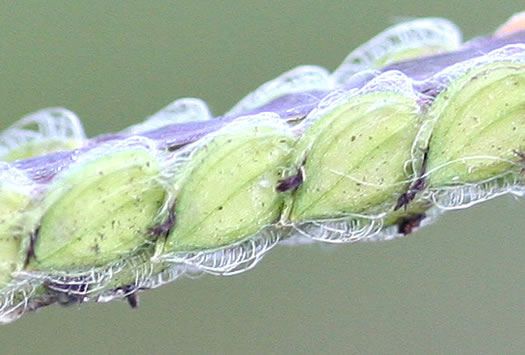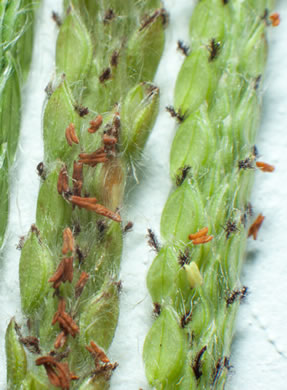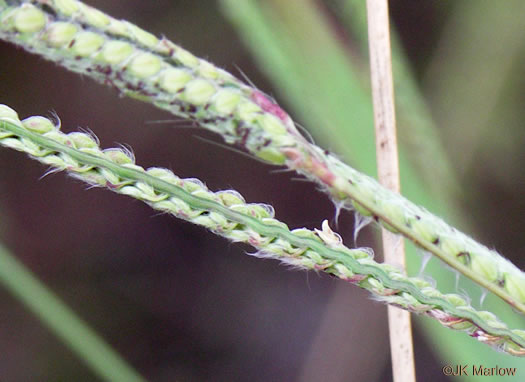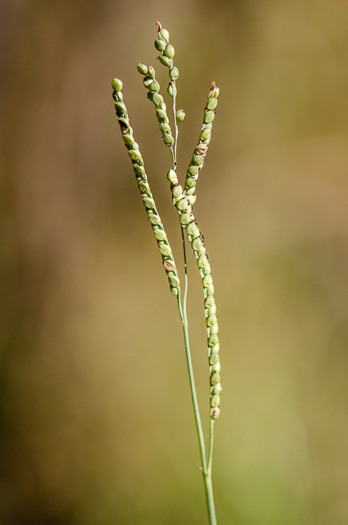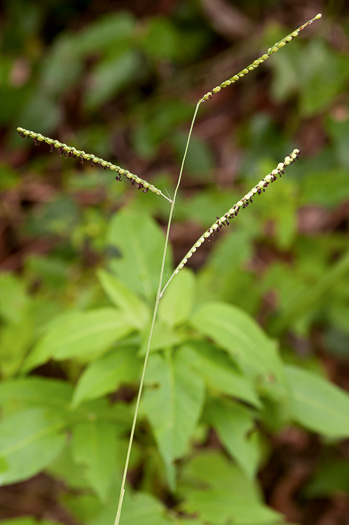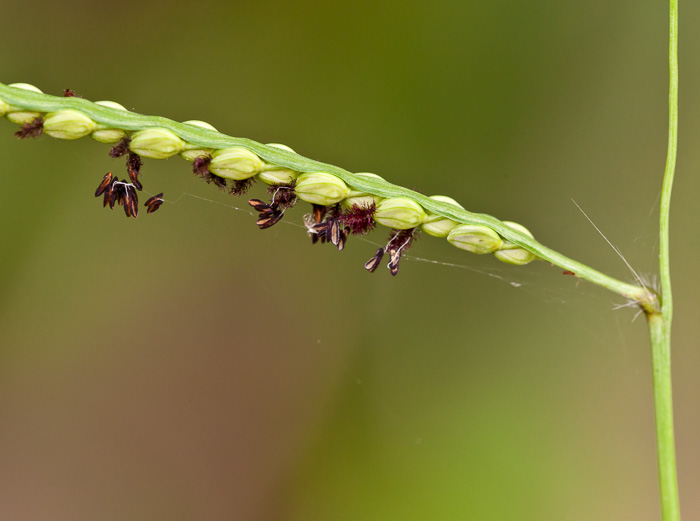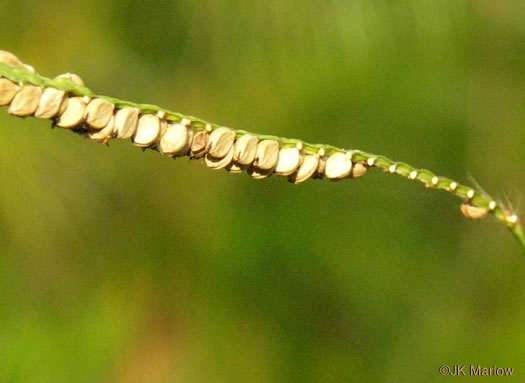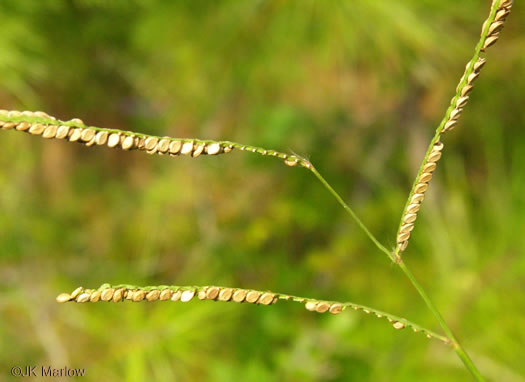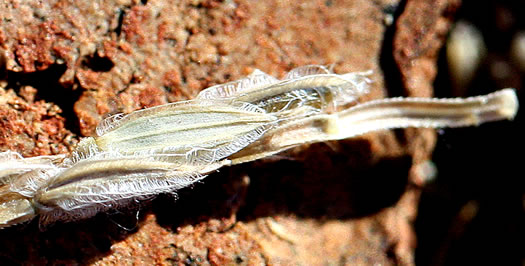Your search found 208 image(s) illustrating the term "spikelet." For a written explanation, click on "spikelet" in the Glossary.
To see larger pictures, click or hover over the thumbnails.
To go to the plant's detail page, click its name.
 Poverty Oatgrass,
Danthonia spicata
Poverty Oatgrass,
Danthonia spicata
Panicle 2-5cm long, the stiff short branches bearing a single spikelet, per Manual of the Grasses of the United States (Hitchcock & Chase, 1950).
 Domestic Oats,
Avena sativa
Domestic Oats,
Avena sativa
Spikelets 15-30mm long, 6-10mm wide. Glumes usually 9-nerved, glabrous, per Vascular Flora of the Carolinas (Radford, Ahles, & Bell, 1968).
 Appalachian Hairgrass,
Avenella flexuosa
Appalachian Hairgrass,
Avenella flexuosa
Spikelets have 2 fertile flowers, each with a lemma with a striking bent awn, per Wildflowers & Plant Communities of the Southern Appalachian Mountains and Piedmont (Spira, 2011).
 Appalachian Hairgrass,
Avenella flexuosa
Appalachian Hairgrass,
Avenella flexuosa
Loose open inflorescence with spikelets at tips of long flexible branches, per Wildflowers & Plant Communities of the Southern Appalachian Mountains and Piedmont (Spira, 2011).
 Silver Hairgrass,
Aira caryophyllea
Silver Hairgrass,
Aira caryophyllea
Pedicels usually 1-2× as long as the spikelets (vs. 2-8× in A. elegans), per Weakley's Flora (2020).
 Elegant Hairgrass,
Aira elegans
Elegant Hairgrass,
Aira elegans
Pedicels usually 2-8× long as spikelets; upper lemma awn 1.5-2.5mm, per Weakley's Flora (2020).
 Green Needlegrass,
Piptochaetium avenaceum
Green Needlegrass,
Piptochaetium avenaceum
Panicle's slender branches 2-4cm long, each bearing 1 or 2 spikelets, per Manual of the Grasses of the United States (Hitchcock & Chase, 1950).
 Arrowfeather,
Aristida purpurascens
Arrowfeather,
Aristida purpurascens
Spikelets with 3 straight to spreading awns, 12-25mm long, per Forest Plants of the Southeast and Their Wildlife Uses (Miller & Miller, 2005).
 Cogongrass,
Imperata cylindrica
Cogongrass,
Imperata cylindrica
Spikelike, tightly branched panicle. Spikelets obscured by silky hairs, per Nonnative Invasive Plants of Southern Forests (Miller, 2003).
 Timothy,
Phleum pratense ssp. pratense
Timothy,
Phleum pratense ssp. pratense
Panicle dense spikelike, cylindrical. Spikelets strongly flattened, 1-flowered, per Vascular Flora of the Carolinas (Radford, Ahles, & Bell, 1968).
 Smut-grass,
Sporobolus indicus
Smut-grass,
Sporobolus indicus
Sporobolus is one of many genera with one floret per spikelet, per Wildflowers of the Eastern United States (Duncan & Duncan, 1999).
 West Indian Dropseed,
Sporobolus jacquemontii
West Indian Dropseed,
Sporobolus jacquemontii
Primary branches appressed to strongly ascending, spikelet-bearing to base, per Grass Manual on the Web.
 Rough Dropseed,
Sporobolus clandestinus
Rough Dropseed,
Sporobolus clandestinus
Spikelets 4-8mm. Lemma pubescent, usually conspicuously shorter than palea, per Weakley's Flora (2020).
 Pink Muhlygrass,
Muhlenbergia capillaris
Pink Muhlygrass,
Muhlenbergia capillaris
Spikelets one-flowered, awns 3-12mm long, per Vascular Flora of the Carolinas (Radford, Ahles, & Bell, 1968).
 Nimblewill,
Muhlenbergia schreberi
Nimblewill,
Muhlenbergia schreberi
Ear [inflorescence] 5" long; earlet [spikelet] sharp pointed with 1 long awn, per Field Guide to the Grasses, Sedges & Rushes of the US (Knobel, 1899) (Faust, 1977).
 Nimblewill,
Muhlenbergia schreberi
Nimblewill,
Muhlenbergia schreberi
Spikelets one-flowered, the rachilla disarticulating above the glumes, per Manual of the Grasses of the United States (Hitchcock & Chase, 1950).
 Autumn Bentgrass,
Agrostis perennans
Autumn Bentgrass,
Agrostis perennans
Spikelets usually not clustered near the tips of the branchlets, per Weakley's Flora (2012).
 Autumn Bentgrass,
Agrostis perennans
Autumn Bentgrass,
Agrostis perennans
Spikelets scattered, but absent from the basal portion of panicle branches, per Wildflowers of the Eastern United States (Duncan & Duncan, 1999).
 Coastal Bog Bentgrass,
Agrostis altissima
Coastal Bog Bentgrass,
Agrostis altissima
Spikelets usually clustered near the tips of the branchlets, per Weakley's Flora (2012).
 Nuttall's Reedgrass,
Greeneochloa coarctata
Nuttall's Reedgrass,
Greeneochloa coarctata
Spikelets 1-flowered. Glumes 6-7mm long, scabrous, long-acuminate, per The Grasses of North Carolina (Blomquist, 1948).
 Bearded Shorthusk,
Brachyelytrum erectum
Bearded Shorthusk,
Brachyelytrum erectum
Inflorescence ~ 4-7" long, spikelets strongly ascending with very long awns, per Vascular Plants of North Carolina.
 Toothache Grass,
Ctenium aromaticum
Toothache Grass,
Ctenium aromaticum
A recurved 1-sided spike bearing spikelets in 2 rows, with conspicuous awns, per Atlantic Coastal Plain Wildflowers (Nelson, 2006).
 Florida Toothache Grass,
Ctenium floridanum
Florida Toothache Grass,
Ctenium floridanum
Spikelets pectinately arranged on one side of a continuous rachis, per Manual of the Grasses of the United States (Hitchcock & Chase, 1950).
 Crowfoot Grass,
Dactyloctenium aegyptium
Crowfoot Grass,
Dactyloctenium aegyptium
Rachis end projects in a point beyond spikelets, which lie along one side, per Manual of the Grasses of the United States (Hitchcock & Chase, 1950).
 Goosegrass,
Eleusine indica
Goosegrass,
Eleusine indica
Spikelets in 2 rows on one side of spikes, lemmas and glumes awnless, per Wildflowers of the Eastern United States (Duncan & Duncan, 1999).
 Bermuda Grass,
Cynodon dactylon
Bermuda Grass,
Cynodon dactylon
Spikelets 1-flowered, awnless, sessile in 2 rows along one side of rachis, per Manual of the Grasses of the United States (Hitchcock & Chase, 1950).
 Dune Fingergrass,
Eustachys petraea
Dune Fingergrass,
Eustachys petraea
Spikelets closely arranged on 2 sides of a 3-sided spike, per Wildflowers of the Eastern United States (Duncan & Duncan, 1999).
 Green Sprangletop,
Disakisperma dubium
Green Sprangletop,
Disakisperma dubium
Seedhead branches triangular in cross-section. Spikelets have 4-7 florets, per Yavapai County Native & Naturalized Plants.
 Catchfly Cutgrass,
Leersia lenticularis
Catchfly Cutgrass,
Leersia lenticularis
Blades lax, 1-2cm wide. Panicle open; spikelets closely imbricate, per Manual of the Grasses of the United States (Hitchcock & Chase, 1950).
 White Cutgrass,
Leersia virginica
White Cutgrass,
Leersia virginica
Spikelets oblong, closely appressed to the branchlets, per Manual of the Grasses of the United States (Hitchcock & Chase, 1950).
 White Cutgrass,
Leersia virginica
White Cutgrass,
Leersia virginica
Leersia's spikelets are one-flowered, strongly compressed laterally, per Manual of the Grasses of the United States (Hitchcock & Chase, 1950).
 Rice Cutgrass,
Leersia oryzoides
Rice Cutgrass,
Leersia oryzoides
Spikelets elliptic, sparsely hispidulous, per Manual of the Grasses of the United States (Hitchcock & Chase, 1950).
 Rice Cutgrass,
Leersia oryzoides
Rice Cutgrass,
Leersia oryzoides
Axillary panicles partly included in the sheaths, spikelets cleistogamous, per Manual of the Grasses of the United States (Hitchcock & Chase, 1950).
 Southern Wild-rice,
Zizania aquatica var. aquatica
Southern Wild-rice,
Zizania aquatica var. aquatica
Erect upper branches with female spikelets, spreading lower branches w male, per Wildflowers of the Eastern United States (Duncan & Duncan, 1999).
 Perennial Foxtail-grass,
Setaria parviflora
Perennial Foxtail-grass,
Setaria parviflora
Spikelets 2-2.5 or even 3mm long; bristles 1-3x or even 6x long as spikelet, per Manual of the Grasses of the United States (Hitchcock & Chase, 1950).
 Yellow Foxtail,
Setaria pumila
Yellow Foxtail,
Setaria pumila
Longer bristles 2-3x as long as the spikelet, per Manual of the Grasses of the United States (Hitchcock & Chase, 1950).
 Yellow Foxtail,
Setaria pumila
Yellow Foxtail,
Setaria pumila
4-12 bristles below each spikelet, per Weakley's Flora (2020).
 Coastal Plain Bristlegrass,
Setaria corrugata
Coastal Plain Bristlegrass,
Setaria corrugata
Bristles green or purple, to 2cm long - much exceeding the spikelets, per Manual of the Grasses of the United States (Hitchcock & Chase, 1950).
 Coastal Plain Bristlegrass,
Setaria corrugata
Coastal Plain Bristlegrass,
Setaria corrugata
Bristles 1-3 below each spikelet, per Vascular Flora of the Carolinas (Radford, Ahles, & Bell, 1968).
 Nodding Foxtail Grass,
Setaria faberi
Nodding Foxtail Grass,
Setaria faberi
Panicle conspicuously nodding; spikelets about 3mm long, per Manual of the Grasses of the United States (Hitchcock & Chase, 1950).
 Dune Sandbur,
Cenchrus tribuloides
Dune Sandbur,
Cenchrus tribuloides
Involucre of spines fused into a bur; spines 4-8mm long, spikelets concealed, per Weakley's Flora (2015).
 Tender Fountaingrass,
Cenchrus setaceus
Tender Fountaingrass,
Cenchrus setaceus
Pennisetum's spikelets are surrounded by an involucre of bristles, per Manual of the Grasses of the United States (Hitchcock & Chase, 1950).
 Shortleaf Basketgrass,
Oplismenus setarius
Shortleaf Basketgrass,
Oplismenus setarius
Racemes subglobose, each w about 5 spikelets; awn of first glume 4-8mm long, per Manual of the Grasses of the United States (Hitchcock & Chase, 1950).
 Rough Barnyard-grass,
Echinochloa muricata var. muricata
Rough Barnyard-grass,
Echinochloa muricata var. muricata
Spikelets > 3.5mm long. Sterile lemma usually awned, the awn 6-25mm long, per Weakley's Flora.
 Swamp Barnyard-grass,
Echinochloa walteri
Swamp Barnyard-grass,
Echinochloa walteri
Panicle branches spikelike, spikelets congested on short secondary branches, per Wildflowers of the Eastern United States (Duncan & Duncan, 1999).
 Water Paspalum,
Paspalum fluitans
Water Paspalum,
Paspalum fluitans
Panicle branches extend beyond outermost spikelets & disarticulate at maturity, per Weakley's Flora.
 Sour Paspalum,
Paspalum conjugatum
Sour Paspalum,
Paspalum conjugatum
Spikelets solitary, ovate, light yellow, conspicuously ciliate-fringed, per Manual of the Grasses of the United States (Hitchcock & Chase, 1950).
 Dallis-grass,
Paspalum dilatatum ssp. dilatatum
Dallis-grass,
Paspalum dilatatum ssp. dilatatum
Terminal racemes with 3-7 alternate spreading branches, spikelets 4-rowed, per Forest Plants of the Southeast and Their Wildlife Uses (Miller & Miller, 2005).
 Dallis-grass,
Paspalum dilatatum ssp. dilatatum
Dallis-grass,
Paspalum dilatatum ssp. dilatatum
Spikelets ovate, acuminate, 3-4mm [anthers & feathery stigmas protruding], per Vascular Flora of the Carolinas (Radford, Ahles, & Bell, 1968).
 Dallis-grass,
Paspalum dilatatum ssp. dilatatum
Dallis-grass,
Paspalum dilatatum ssp. dilatatum
Spikelets have long silky hairs like P. urvillei, but are larger (3-3.5mm), per Wildflowers of the Eastern United States (Duncan & Duncan, 1999).
 Vasey Grass,
Paspalum urvillei
Vasey Grass,
Paspalum urvillei
Spikelets 4-rowed, light-green often with dark flowering parts extending, per Forest Plants of the Southeast and Their Wildlife Uses (Miller & Miller, 2005).
 Vasey Grass,
Paspalum urvillei
Vasey Grass,
Paspalum urvillei
Spikelets 2-3mm with conspicuous silky hairs, a rare occurrence in Paspalum, per Wildflowers of the Eastern United States (Duncan & Duncan, 1999).
 Field Crowngrass,
Paspalum laeve var. laeve
Field Crowngrass,
Paspalum laeve var. laeve
Spikelets orbicular, 2.5-3mm broad, in two rows, per Vascular Flora of the Carolinas (Radford, Ahles, & Bell, 1968).
 Early Crowngrass,
Paspalum praecox
Early Crowngrass,
Paspalum praecox
Racemes terminal, longest usually < 6cm. Spikelets flattened, yellowish-green, per Vascular Flora of the Carolinas (Radford, Ahles, & Bell, 1968).
 Florida Paspalum,
Paspalum floridanum
Florida Paspalum,
Paspalum floridanum
Racemes 3-13cm long (longest > 6cm). Spikelets in 4 rows or by abortion 3 or 2, per Vascular Flora of the Carolinas (Radford, Ahles, & Bell, 1968).
 Florida Paspalum,
Paspalum floridanum
Florida Paspalum,
Paspalum floridanum
Spikelets suborbicular or broadly ellipsoid; pedicels 1-2mm long, per Vascular Flora of the Carolinas (Radford, Ahles, & Bell, 1968).
 Florida Paspalum,
Paspalum floridanum
Florida Paspalum,
Paspalum floridanum
Spikelets 3-4mm long, flat-rounded, white waxy sometimes brown or peeling, per Forest Plants of the Southeast and Their Wildlife Uses (Miller & Miller, 2005).
 Florida Paspalum,
Paspalum floridanum
Florida Paspalum,
Paspalum floridanum
Terminal racemes with 2-7 ascending branches, w large spikelets in 2 rows, per Forest Plants of the Southeast and Their Wildlife Uses (Miller & Miller, 2005).
 Slender Crabgrass,
Digitaria filiformis
Slender Crabgrass,
Digitaria filiformis
Spikelet, showing shiny dark brown fertile lemma beneath upper glume.
 Hairy Crabgrass,
Digitaria sanguinalis
Hairy Crabgrass,
Digitaria sanguinalis
Spikelets about 3mm long, sterile lemma strongly nerved, per Manual of the Grasses of the United States (Hitchcock & Chase, 1950).

